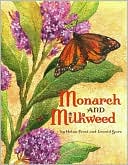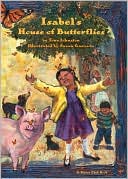August 21-November 7 (approximate). The monarch butterfly (Danaus plexippus) of North America begins an amazing migration of up to 3,000 miles in late August to escape the northern winter. Some 140 million insects travel to small forests in southern California (west of the Rocky Mountains) and Mexico (east of the Rockies, via central and coastal Texas) from as far as Minnesota and New England. In late spring, they will journey north again. Given that their lifespan is 4-6 weeks, the butterflies making the same annual migration are the grandchildren of the grandchildren of the butterflies that overwintered 10 months previously. For more information: www.monarchwatch.org and www.monarchlab.umn.edu
-The Teacher's Calendar, 2008-2009
-The Teacher's Calendar, 2008-2009
 Frost, Helen.
Frost, Helen.Gore, Leonid.
Monarch and Milkweed.
2008.
Atheneum Books for Young Readers.
Summary from Barnes & Noble:
Every spring the monarch butterfly migrates thousands of miles in search of the ideal milkweed plant. When she finds it, she lays her eggs on the plant, so when each egg hatches, the baby caterpillar can feed on the milkweed leaves. The milkweed plant then provides the perfect protection as the caterpillar turns into one of nature's wonders, a chrysalis, before transforming into an even greater wonder: a monarch butterfly. And once the newborn butterfly soars away, the milkweed seeds fly away on the wind and start this cycle over again.
I loved this story for several reasons:
- The illustrations immediately caught my eye... there was something about them that I'm not even sure how to describe - splatter paint maybe... or some kind of texture printing? Whatever the medium used, it worked! Definitely an eye catcher!
- The book is a wonderful resource in any plant or butterfly unit because together, we see how the plants (milkweed) and the butterflies (monarchs) rely on each other to complete the "circle of life."
- The author's note at the end of the book describes in kid-friendly terminology (while not entirely kid-friendly as far as reading comprehension goes)the monarch migration that takes place each fall and spring. I think kids will be amazed to learn that the butterflies that migrate south in the fall are the great, great grandparents of the ones that make the return journey north come spring!
 Johnston, Tony.
Johnston, Tony.Isabel's House of Butterflies.
2003.
Sierra Club Books for Children.
Summary from Barnes & Noble:
Outside her home in Michoacan, Mexico, grows eight-year-old Isabel's greatest treasure: an oyamel tree. Here, every autumn, a miracle happens-for Isabel's tree is the wintering place for thousands upon thousands of monarch butterflies that migrate from the north. When they flutter down to roost, they transform Isabel's tree into La casa de las mariposas-The House of Butterflies. But this wonder is in danger of disappearing forever. Isabel's family is poor, and it is a cruel, dry year for Papa's meager crop of corn and beans. Soon, chopping down the tree to sell its wood may be the family's only hope for survival. What will happen to the butterflies then?
I really enjoyed reading this and was intrigued by the different way of life that is depicted throughout the entire story. We (and children) will see just how different like if for different people throughout the world and their ways of handling the hardships that they're up against versus how we do. Isabel takes pleasure in knowing that the butterflies will return year after year... But, just as the summary states, "What will happen to the butterflies then?" Readers never really find out what happens... does the family have to cut down the precious oyamel tree? Or does Isabel's plan help the family survive without having to chop down their precious butterfly tree? I was a bit disappointed that we didn't see an ending... perhaps the story was meant to end like this to allow readers the opportunity to dream up their own ending...
 O'Flatharta, Antoine.
O'Flatharta, Antoine.Hurry and the Monarch.
2005.
Alfred A. Knopf.
Guided Reading Level: N
Summary from Barnes & Noble:
When the beautiful orange Monarch on her fall migration route from Canada to Mexico stops to rest at Wichita Falls, Texas, she makes friends with an old tortoise called Hurry. She tells him, "Maybe one day you'll break out of that shell, grow wings, and fly away," and then she is off again with millions of other Monarchs. In the spring, she stops again at Hurry's garden just long enough to lay her eggs and head north to Canada. Embedded in this lyrical and tender fictional presentation are the fascinating facts about the amazing 2,000-mile migration and the life cycle of butterflies.
I loved the message (I found to be) portrayed in the book - the world is full of places waiting to be seen! I think that one phrase in particular makes this book appropriate for not only young children learning about the life cycle and migration of the monarch butterfly, but also appropriate for graduating seniors (high school or college).
"What's your hurry?" asks Hurry.
"I'm off to see the world. What do you think it's like?" asks the butterfly.
"I imagine - " says Hurry slowly,
"I imagine that it's like my garden.
A place full of astonishing things."
"I can't wait," says the young
monarch, flying away.
Either way - however you choose to look at this book, educationally or as a motivational gift, it's definitely worth adding to your TBR pile!
Lesson Plans/Learning Activities:
If you're interested in finding out more information about any of the books reviewed or if you'd like to purchase the books, click the cover image for a link to Amazon.com.








0 comments:
Post a Comment